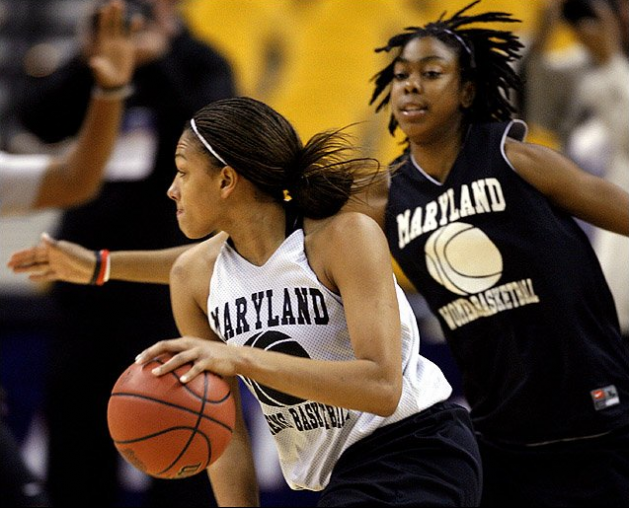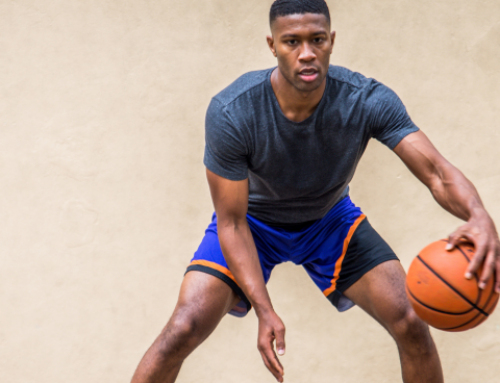Conditioning Tips From Maryland's Women's Basketball
Strength coach Corliss Fingers talks about the conditioning principles that make the Lady Terrapins basketball team a perennial power.
1. I believe in sport-specific conditioning; it should mimic what they do in a game. So we do sprint-related conditioning. Our basketball team doesn’t run miles.
2. Rest times are based on timeouts. We get 20-second timeouts, full timeouts and TV timeouts. That’s all the rest the team is going to get.
3. I try to keep most activities on the court. Some days we run the steep stairs located in the student section of the arena; other days we run the hills right outside of Comcast.
4. They are not allowed to whine, not allowed to say “I can’t,” not allowed to put their hands on their knees. Anything I don’t like just means more pushups.
5. If anyone—it doesn’t matter who—misses a time during a conditioning drill, everyone has to do it over.
6. We condition three days a week. One of those is straight conditioning; the other two are agility and plyo days, where they are being conditioned during the workout and at the end of it.
7. I give them something conditioning-based at the end of training, but without a lot of reps—maybe 8 to 10 full court sprints. Sprint down, come back, then rest for 10 seconds. I added that closer to the start of the season, which is why the team felt comfortable in overtime. They were used to getting that extra work after weightlifting or training.
8. At the beginning of the season, we have a lot of non-conference games that we condition and train through. But once we get to the more important, competitive games, we don’t do conditioning— except for full court sprints after missed lay-ups, missed plays or someone not paying attention.
9. The team knows that Mondays are heavy conditioning days, but they don’t know what the day will include. And since they don’t know, their minds are ready for anything. When I tell them, “This is overtime—get ready,” they know it’s going to get that much harder. So I don’t just condition their bodies, I condition their minds, too. That’s why, when the buzzer sounds for overtime, they’re ready. It’s almost like a release for them. They’re like: “We’re ready for this overtime. We don’t know what to expect, but we’re ready for it.”
10. On a typical conditioning day, we do five 300-yard shuttles. The most time I give them to complete each shuttle is 72 seconds, and that’s usually during the first day back. We work our times down; right before the season, everyone—my posts, guards, everyone—has to make it in 66 seconds. To get a full recovery, we start off with four minutes of rest between shuttles and work down to two minutes.
11. Even though they think what they’re doing is hard, someone else at another university is doing the same thing and wants to beat their behinds. So when the team feels like they don’t want to do it, I remind them there are other people out there working to take away their title. For anyone who is training and wanting to be better, you just need to know that someone is out there training harder and trying to reach the same dream you have.
Photo: AP Photo/Stephan Savoia.
RECOMMENDED FOR YOU
MOST POPULAR
Conditioning Tips From Maryland's Women's Basketball
Strength coach Corliss Fingers talks about the conditioning principles that make the Lady Terrapins basketball team a perennial power.
1. I believe in sport-specific conditioning; it should mimic what they do in a game. So we do sprint-related conditioning. Our basketball team doesn’t run miles.
2. Rest times are based on timeouts. We get 20-second timeouts, full timeouts and TV timeouts. That’s all the rest the team is going to get.
3. I try to keep most activities on the court. Some days we run the steep stairs located in the student section of the arena; other days we run the hills right outside of Comcast.
4. They are not allowed to whine, not allowed to say “I can’t,” not allowed to put their hands on their knees. Anything I don’t like just means more pushups.
5. If anyone—it doesn’t matter who—misses a time during a conditioning drill, everyone has to do it over.
6. We condition three days a week. One of those is straight conditioning; the other two are agility and plyo days, where they are being conditioned during the workout and at the end of it.
7. I give them something conditioning-based at the end of training, but without a lot of reps—maybe 8 to 10 full court sprints. Sprint down, come back, then rest for 10 seconds. I added that closer to the start of the season, which is why the team felt comfortable in overtime. They were used to getting that extra work after weightlifting or training.
8. At the beginning of the season, we have a lot of non-conference games that we condition and train through. But once we get to the more important, competitive games, we don’t do conditioning— except for full court sprints after missed lay-ups, missed plays or someone not paying attention.
9. The team knows that Mondays are heavy conditioning days, but they don’t know what the day will include. And since they don’t know, their minds are ready for anything. When I tell them, “This is overtime—get ready,” they know it’s going to get that much harder. So I don’t just condition their bodies, I condition their minds, too. That’s why, when the buzzer sounds for overtime, they’re ready. It’s almost like a release for them. They’re like: “We’re ready for this overtime. We don’t know what to expect, but we’re ready for it.”
10. On a typical conditioning day, we do five 300-yard shuttles. The most time I give them to complete each shuttle is 72 seconds, and that’s usually during the first day back. We work our times down; right before the season, everyone—my posts, guards, everyone—has to make it in 66 seconds. To get a full recovery, we start off with four minutes of rest between shuttles and work down to two minutes.
11. Even though they think what they’re doing is hard, someone else at another university is doing the same thing and wants to beat their behinds. So when the team feels like they don’t want to do it, I remind them there are other people out there working to take away their title. For anyone who is training and wanting to be better, you just need to know that someone is out there training harder and trying to reach the same dream you have.
Photo: AP Photo/Stephan Savoia.












